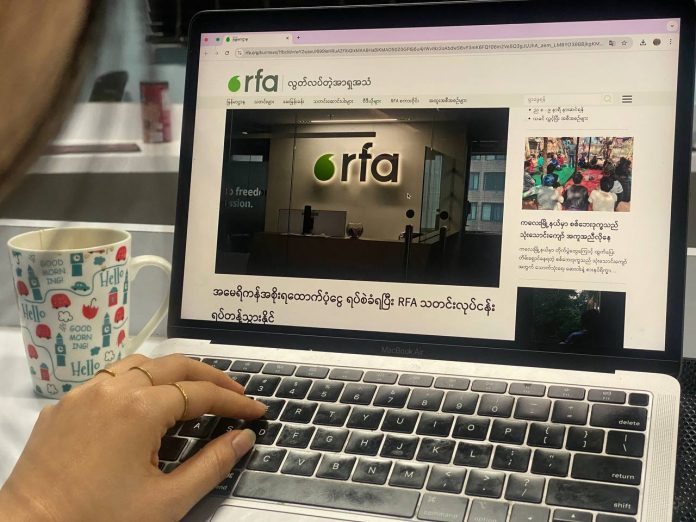Following U.S. President Donald Trump’s executive order on March 14 a notice to terminate funding for the U.S. Agency for Global Media (USAGM) was shared with news outlets under its oversight, including the Voice of America (VOA), Radio Free Europe/Radio Liberty (RFE/RL), and Radio Free Asia (RFA).
“About a year ago, when military operations were intense in our area and all [internet and telephone] lines were down, we all went back to listening to the radio,” a resident of Myanmar’s southernmost Tanintharyi Region told DVB on the condition of anonymity.
“Now I’ve lost two options. I can no longer choose VOA or RFA. What if more outlets follow? If they do, our news flow will be completely disrupted,” the resident added.
VOA broadcasts in 44 languages, including Burmese and various ethnic languages. RFA broadcasts in nine languages, including Burmese. “I think it will have a significant impact on the media [landscape for Myanmar],” Thiha Saw, a veteran journalist, told DVB.
Michael Abramowitz, the VOA director, told Reuters that nearly all of his 1,300 staff members — including journalists, producers, and assistants — have been placed on unpaid leave starting March 15. VOA stopped sharing news updates the following day, March 16.
RFA spokesperson Rohit Mahajan told Reuters on March 19 that hundreds of U.S.-based RFA staff members would be placed on unpaid leave starting this week. RFA Burmese announced on March 21 that it is going to temporarily suspend a significant portion of its broadcasting operations.
“We have been regularly broadcasting for nearly three decades for millions of people in Myanmar. We have exposed the various hardships and injustices faced daily by the people of Myanmar,” stated Kyaw Kyaw Aung, the head of the RFA Burmese Service, in a video shared on social media.
Myanmar has experienced widespread and recurring disruptions to telecommunications networks since the 2021 military coup. In areas of the country where conflict has occurred, phone and internet shutdowns have been imposed by the regime in Naypyidaw.
Internet penetration was at 44 percent last year, which is a “historic low,” according to a Freedom House report released in December 2024. It labelled the country “not free” due to several factors, including localized internet blocks and data price hikes following the 2021 coup.
“It reminded me of February 1, 2021 when the Burma military seized power, they immediately shut down DVB, and [our signal] suddenly disappeared,” said Aye Chan Naing, the chief editor at DVB.
“It’s almost as if there’s been a coup there [in the U.S.]. These are news outlets that reach remote mountainous areas through radio waves. Now only the BBC remains on shortwave [radio in Myanmar],” he added, referring to the British Broadcasting Corporation’s daily Burmese language radio news service.
Some communities in Myanmar have installed Starlink satellite internet service, or have purchased SIM cards from neighboring countries like Thailand. But these options can be too expensive and beyond the reach of most people in Myanmar.
Radio remains a vital source of information due to its low cost and accessibility. “News about natural disasters or weather conditions is obtained by [listening to] radio. Especially in areas where the internet has been cut off,” Myint Kyaw, an independent journalist, told DVB.
Reporters Without Borders (RSF) issued a statement on March 17 “sounding the alarm over the risks facing USAGM staffers around the world.”
“By shutting down USAGM and its media outlets, the Trump administration is sending a chilling signal: authoritarian regimes such as Beijing and Moscow now have free rein to spread their propaganda unchecked,” wrote Thibaut Bruttin, the RSF Director General.
RSF has documented that nine journalists working for USAGM news outlets, including jailed Myanmar journalist Sithu Aung Myint, are imprisoned by authoritarian regimes around the world, including Myanmar’s.
Fifty-three journalists and media workers are currently in prison in Myanmar, according to media monitoring group Athan. It added that 217 media workers have been arrested with 79 convicted and 164 released.
Fifteen media organizations, including DVB, have had their publication licenses revoked by the regime. Since 2021, Myanmar has become one of the world’s biggest jailers of journalists, second only to China, according to the Committee to Protect Journalists (CPJ). It is ranked 171 out of 180 countries, which is near the bottom of the RSF 2024 World Press Freedom index.



